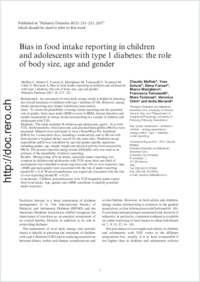Bias in food intake reporting in children and adolescents with type 1 diabetes: the role of body size, age and gender
- Maffeis, Claudio Pediatric Diabetes and Metabolic Disorders Unit, University of Verona, Italy
- Schutz, Yves Department of Integrative Physiology, University of Fribourg, Switzerland
- Fornari, Elena Pediatric Diabetes and Metabolic Disorders Unit, University of Verona, Italy
- Marigliano, Marco Pediatric Diabetes and Metabolic Disorders Unit, University of Verona, Italy
- Tomasselli, Francesca Pediatric Diabetes and Metabolic Disorders Unit, University of Verona, Italy
- Tommasi, Mara Pediatric Diabetes and Metabolic Disorders Unit, University of Verona, Italy
- Chini, Veronica Pediatric Diabetes and Metabolic Disorders Unit, University of Verona, Italy
- Morandi, Anita Pediatric Diabetes and Metabolic Disorders Unit, University of Verona, Italy
-
01.05.2017
Published in:
- Pediatric Diabetes. - 2017, vol. 18, no. 3, p. 213–221
English
An assessment of total daily energy intake is helpful in planning the overall treatment of children with type 1 diabetes (T1D). However, energy intake misreporting may hinder nutritional intervention.Aims: To assess the plausibility of energy intake reporting and the potential role of gender, body mass index (BMI) z-score (z-BMI), disease duration and insulin requirement in energy intake misreporting in a sample of children and adolescents with T1D.Methods: The study included 58 children and adolescents aged 8–16 yr with T1D. Anthropometry, blood pressure and glycated hemoglobin (HbA1c) were measured. Subjects were instructed to wear a SenseWear Pro Armband (SWA) for 3 consecutive days, including a weekend day and to fill out with their parents a weighed dietary record for the same days. Predicted energy expenditure (pEE) was calculated by age and gender specific equations, including gender, age, weight, height and physical activity level (assessed by SWA). The percent reported energy intake (rEI)/pEE ratio was used as an estimate of the plausibility of dietary reporting.Results: Misreporting of food intake, especially under-reporting, was common in children and adolescents with T1D: more than one-third of participants were classified as under- reporters and 10% as over-reporters. Age, z-BMI and male gender were associated with the risk of under-reporting (model R2 = 0.5). Waist circumference was negatively associated with the risk of over-reporting (model R2 = 0.25).Conclusions: Children and adolescents with T1D frequently under-report their food intake. Age, gender and z-BMI contribute to identify potential under-reporters.
- Faculty
- Faculté des sciences et de médecine
- Department
- Département de Médecine
- Language
-
- English
- Classification
- Biological sciences
- License
- License undefined
- Identifiers
-
- RERO DOC 288977
- DOI 10.1111/pedi.12376
- Persistent URL
- https://folia.unifr.ch/unifr/documents/305761
Statistics
Document views: 81
File downloads:
- sch_bfi.pdf: 223
